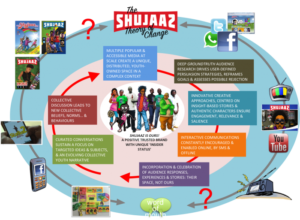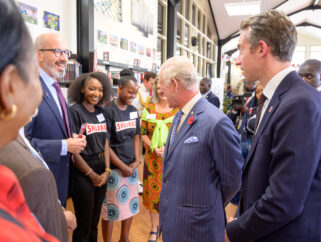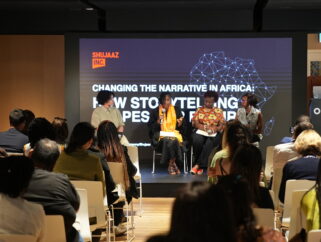BIG CHANGES START WITH SMALL TALK: 4 components of a powerful youth conversation [ARCHIVE]
- 7 Feb 2016

At Shujaaz, we’ve learned that big changes start with small talk. Because when small talk starts off in the right direction it turns into group conversation. And when group conversations focus on big ideas they can quickly develop into re-evaluations of shared social norms of thinking and behaviour. And when multiple people start reflecting on the merits of their norms, they are already in the process of social change.
The progression from small talk to social change is the core of the Shujaaz Theory of Change, which guides all our media and outreach work in Kenya and Tanzania. Put succinctly we’ve learned that collective discussion leads to collective belief. Shujaaz therefore aims to be both catalyst and curator for important conversations that can nudge our audience towards valuable innovation in ideas and actions. Hence, understanding collective discussion – or conversation – from the perspective of young people in East Africa is of utmost importance for everything we do.
According to our most recent qualitative field research done in Kenya in 2015/16, in order to be engaging, a conversation among young people needs four key components or key characteristics: it has to be relevant, it must have a peer leader, it should offer participants an opportunity to shine, and have an irritant or an element of confusion.
Relevance
We are not the first to talk about relevance. Yes, it is obvious that a conversation has to involve a topic relevant to the young people’s real life interests and concerns. However, what we sometimes see missing is the understanding that when it comes to young people relevance is a fluid concept, what is relevant now is not relevant tomorrow. In this case, understanding timing is key to the continuity of a conversation. For example, contraceptives are important for a girl in a relationship; but the minute she and her boyfriend break up, the topic is no longer relevant. For Shujaaz to help keep an important conversation alive, we need to know not just the overall context of young people’s lives but the possible nuances of the participant’s status in a given period so we can adjust the angle and keep the topic engaging and relevant.
A peer leader
Opposite to the general perception, a meaningful conversation does not start once a group of young people gets together – it starts when one peer, a leader, shows up. A leader is typically a person, who is a) looked up to by other members of the group because of their personal qualities or lifestyle (of course), and b) is quick to come up with ideas for a group activity (e.g. a rave or even a crime). This person is respected and cherished by the group; he or she is the one who can initiate a conversation, steer it in a certain direction and keeping it alive.
An opportunity to shine
While a leader will be shaping and guiding the conversation, the pace of the conversation should allow other members of the group to interject by sharing their own experience in similar situations and showcase their “smarts” by offering a solution they tested. The opportunity to shine allows conversation participants to assume a role of the leader for a short moment, just enough to make them feel good about themselves and interested in remaining a part of the conversation.
A confusion/irritant
Familiar situations that have an element that is unexpected and strange provoke engaging conversations. For example, in our study we offered participants a scenario where a father had to give money to his daughter for an abortion. This scenario provoked an intense emotional discussion, because a father is not typically seen as a part of such family conversations. Yet, it turned out that young men do not mind taking up this role and express “the other side’s” point of view and give (often unusual but thoughtful) advice.
One more insight to factor-in: for a conversation to grow into an activity/action young people want a detailed (read: step-by-step) plan on how to develop an idea into a group activity. Hanging out as a gang, clique or a team is natural for young people; a successful activity follows and exploits this natural pattern. However, as mentioned above, most groups are inert/idle without a leader, whose role is to come up with an idea, develop it into a plan and then supervise the implementation.
To summarize, an impactful conversation unifies a group of young people around a leader, who comes up with a plan where every member has an opportunity to shine and where together the group challenges “adult norms” and bends them to address their needs, relevant at the time of the conversation.





